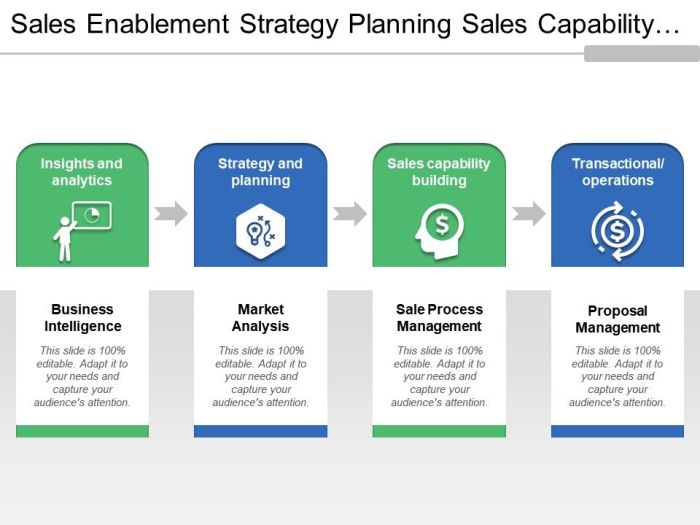Building a Sales Enablement Program takes center stage, inviting readers into a world of business savvy and success. Dive into the key components and implementation strategies for a program that’s bound to elevate your sales team’s performance.
Importance of Sales Enablement Programs

Having a sales enablement program in place is crucial for businesses looking to enhance their sales team’s performance and drive success in the competitive market.
Boosting Sales Team Performance
- Effective training: Sales enablement programs provide comprehensive training to equip sales professionals with the knowledge and skills needed to excel in their roles.
- Streamlined processes: By implementing structured processes and tools, sales enablement programs help sales teams work efficiently and effectively.
- Alignment with marketing: Sales enablement programs ensure alignment between sales and marketing teams, leading to more cohesive strategies and improved overall performance.
Successful Companies with Effective Programs
- HubSpot: Known for its robust sales enablement program that focuses on continuous training and development to empower sales teams.
- Salesforce: Utilizes a data-driven approach in its sales enablement program, leveraging analytics to optimize sales strategies and drive growth.
- IBM: Implements a comprehensive sales enablement program that combines technology, training, and resources to support its sales force in achieving targets.
Key Components of a Sales Enablement Program
In a successful sales enablement program, there are key components that play a vital role in driving the effectiveness of the program. These essential elements encompass training and development, as well as content creation and management.
Training and Development
Training and development are crucial components of a sales enablement program as they equip sales teams with the necessary knowledge and skills to effectively engage with customers and close deals. Continuous training ensures that sales representatives stay updated on product knowledge, sales techniques, and market trends. Development programs help sales professionals enhance their communication, negotiation, and problem-solving skills, enabling them to better address customer needs and drive sales.
Content Creation and Management
Content creation and management are integral to the success of a sales enablement program as they provide sales teams with the resources they need to engage prospects and convert leads into customers. By creating compelling and informative content such as sales collateral, presentations, case studies, and product demos, sales representatives can effectively communicate the value proposition of the products or services they are selling. Proper content management ensures that sales teams have access to up-to-date and relevant materials that support their sales efforts, ultimately contributing to the effectiveness of the program.
Implementing a Sales Enablement Program: Building A Sales Enablement Program

When it comes to setting up a sales enablement program from scratch, there are several key steps to consider in order to ensure its successful adoption and integration within the sales team.
Step 1: Define Goals and Objectives
Before implementing a sales enablement program, it is crucial to clearly define the goals and objectives you want to achieve. This will help guide the development and implementation process.
Step 2: Identify Target Audience
Determine the specific audience within your sales team that will benefit most from the program. Tailoring the content and resources to their needs will increase the program’s effectiveness.
Step 3: Develop Training Materials, Building a Sales Enablement Program
Create comprehensive training materials that cover a range of topics such as product knowledge, sales techniques, and customer communication. These materials should be easily accessible and engaging for the sales team.
Step 4: Implement Tools and Technology
Integrate tools and technology that will support the sales team in their day-to-day activities. This could include CRM systems, communication platforms, and analytics tools to track progress and performance.
Step 5: Provide Ongoing Support and Feedback
Offer continuous support to the sales team through coaching, feedback sessions, and regular check-ins. This will help reinforce the training and ensure that the program is being effectively utilized.
Monitoring and Evaluation
Regularly monitor and evaluate the effectiveness of the sales enablement program by tracking key performance metrics, gathering feedback from the sales team, and making adjustments as needed to improve outcomes.
Technology and Tools for Sales Enablement
In today’s digital age, technology plays a crucial role in supporting sales enablement programs. Various software and tools are available to enhance the efficiency and effectiveness of these programs.
CRM Platforms for Sales Enablement
Customer Relationship Management (CRM) platforms are essential for managing customer interactions and data. Some popular CRM platforms used for sales enablement include:
- Salesforce: Known for its robust features and customization options, Salesforce is a widely used CRM platform that offers comprehensive tools for sales teams.
- HubSpot CRM: HubSpot CRM is a user-friendly platform that integrates seamlessly with other marketing tools, making it easier to track and manage leads.
- Zoho CRM: Zoho CRM is a cost-effective solution that provides a wide range of features to help sales teams streamline their processes.
Choosing the right CRM platform is crucial for the success of a sales enablement program.
Role of Analytics and Data in Sales Enablement
Analytics and data play a vital role in optimizing a sales enablement program. By leveraging data-driven insights, sales teams can make informed decisions and improve their strategies. Some key aspects to consider include:
- Performance Metrics: Tracking key performance indicators (KPIs) such as conversion rates, sales cycle length, and customer acquisition cost can help identify areas for improvement.
- Lead Scoring: Using data to prioritize leads based on their likelihood to convert can help sales teams focus their efforts on high-potential prospects.
- Personalization: Analyzing customer data to create personalized sales pitches and content can lead to higher engagement and conversion rates.
By harnessing the power of technology and data-driven insights, sales enablement programs can drive better results and ultimately boost revenue.
